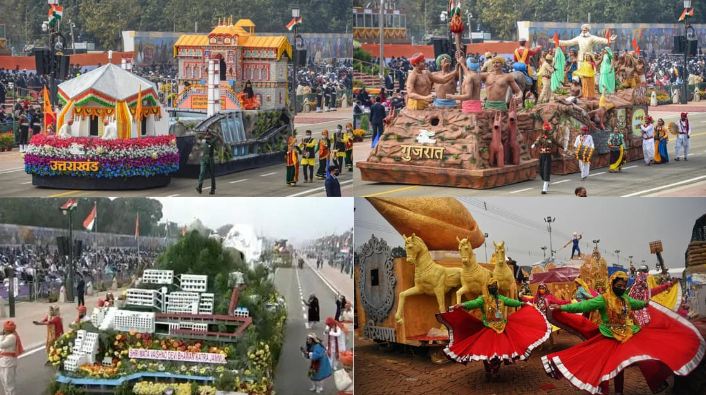Republic Day celebrations this year turned out to be pretty special. The country is shedding its colonial hangover and is adopting its glorious heritage with open arms. Everything is changing- the tableaux, the tunes during Beating the Retreat and other protocols.
Reclaiming ancient glory and cultural identity
The tableau of different state and Ministries were displayed during the Republic Day parade. The tableaux showed India’s glorious heritage like never before.
The front portion of the tableau of Jammu and Kashmir displayed Mata Vaishno Devi Bhawan, located at Katra in the Trikuta mountains of the Jammu division.
Similarly, the first part of Haryana’s tableau showed the conch of Lord Krishna. The tableau of Uttar Pradesh depicted ghats and the newly-inaugurated Kashi Vishwanath Dham. And Uttarakhand’s tableau showed Gurudwara Hemkund Sahib, a holy Sikh site, and the Badrinath temple, which is one of the Char Dham pilgrimage sites.
The tableau of the Ministry of Education and Skill Development too didn’t hold back in displaying India’s cultural glory. It displayed India’s rich tradition in education starting from the Vedas followed by the Gurukul education system, and the ancient universities like Nalanda, which attracted thousands of scholars and students from across the world at the time.
Changes in Beating the Retreat
The same pattern will be carried forward into Beating the Retreat, which marks the culmination of Republic Day celebrations.
This year, ‘Abide with me’, a 19th-century hymn written by Scottish poet Henry Francis Lyte has been removed. It has been replaced by the famous song ‘Ae Mere Watan Ke Logon’, which was written by Kavi Pradeep to commemorate the sacrifices made by Indian soldiers during the 1962 Sino-India war.
As per reports, ‘Abide with me’ has been removed to include a “maximum number of Indian tunes”.
Honouring India’s freedom fighters
India is making a conscious effort to acknowledge the contribution of many of its known and unknown freedom fighters. Due to manipulations, the contribution of many great freedom fighters hasn’t been properly acknowledged in the past.
This time around, the tableau of the Culture Ministry highlighted 150 years of Aurobindo Ghosh, one of India’s greatest intellectuals.
Gujarat’s tableau reminded the country of the century-old, largely forgotten uprising against the British Raj in Bhil dominated Sabarkantha. The British had responded with brutality and the tableau depicted the massacre of 1,200 tribals by the British Raj.
Similarly, the Indian Navy tableau depicted the 1946 naval uprising. The uprising had played a pivotal role in making the British realise that their days in India were over. But the event wasn’t given the place it deserved in India’s modern history.
And India is finally giving centrality to the role of Netaji Subhash Chandra Bose in the freedom struggle.
Now, the Indian Republic will be celebrated beginning on the day Netaji Subhas Chandra Bose was born. The Modi government has announced that the Republic Day celebrations will now begin every year from January 23 instead of January 24 to include the birth anniversary of Netaji Subhas Chandra Bose. And the government is also going to install Netaji’s grand statue, made of granite, at India gate.
Read more: The curious case of George V’s statue in India Gate complex and the re-entry of Bose
Netaji’s legacy is finally being celebrated the way it should always have been. And this is simply a part of the country’s efforts to reclaim its historical glory without any colonial hangover.
